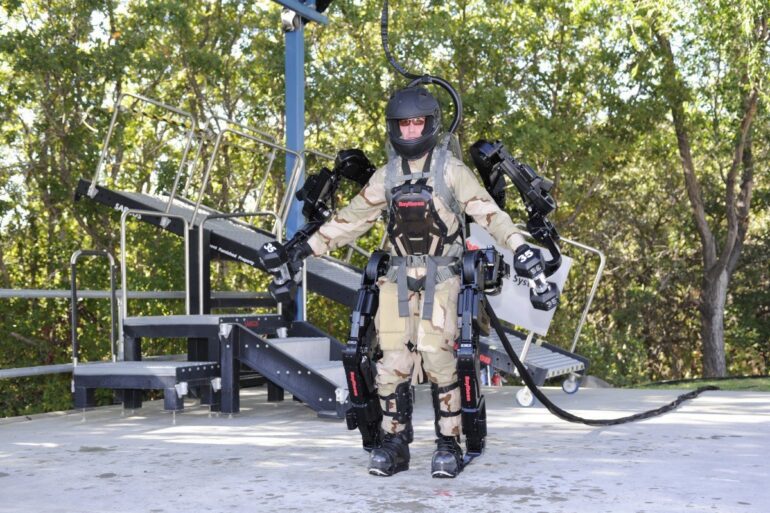TL;DR:
- Military exoskeletons, once limited to the realm of science fiction, are now a reality, combining artificial intelligence (AI) with defense technology.
- Exoskeletons enhance soldiers’ physical abilities, providing superhuman strength, speed, and endurance.
- Integration of AI enables adaptive and optimized performance, pushing the limits of human combat capabilities.
- Ethical concerns and the potential for an AI arms race pose challenges to the deployment of AI-powered exoskeletons.
- Benefits include reduced physical strain on soldiers, improved performance, and new tactical possibilities.
- Progress is being made globally, with the US, Russia, and China investing in AI-enhanced exoskeleton technology.
- The integration of AI into military exoskeletons signifies a transformative leap in defense capabilities.
Main AI News:
In a remarkable fusion of cutting-edge technology and defense capabilities, military exoskeletons are emerging from the realm of science fiction to reshape the landscape of warfare. This groundbreaking development at the intersection of artificial intelligence (AI) and defense technology has the potential to revolutionize the way soldiers operate on the battlefield, granting them unprecedented capabilities.
At their core, exoskeletons are wearable machines that utilize a sophisticated system of electric motors, levers, or hydraulics to augment the physical abilities of the wearer. In military applications, these remarkable devices can endow soldiers with superhuman strength, speed, and endurance, enabling them to bear heavy loads, move swiftly, and operate tirelessly for extended periods.
However, what truly sets these exoskeletons apart is the integration of artificial intelligence. By leveraging AI, these futuristic systems can learn from the user’s movements, adapt, and optimize their performance to cater to individual needs. This symbiotic relationship between man and machine has the potential to redefine the boundaries of human performance in combat situations, opening up a new chapter in military operations.
Nevertheless, the advent and deployment of AI-powered military exoskeletons come with their fair share of challenges. Foremost among them are the ethical implications surrounding their use. The potential for misuse or malfunction raises pressing questions about accountability and control. Moreover, the emergence of an AI-enhanced arms race in warfare technology has the potential to destabilize global security dynamics, necessitating careful considerations.
Notwithstanding these concerns, the advantages offered by military exoskeletons are undeniably compelling. They have the capacity to significantly alleviate physical strain on soldiers, reducing the risk of injuries and enhancing overall performance. Moreover, they unlock new tactical possibilities, such as the ability to carry heavier weaponry or equipment, move swiftly, and operate in otherwise inaccessible environments.
While the development of military exoskeletons is still in its nascent stages, notable progress has already been made. The US military, for example, has been actively testing exoskeletons for several years, yielding promising results. Other nations, including Russia and China, are also investing heavily in this transformative technology, highlighting the global interest in the potential of AI-enhanced exoskeletons.
The integration of AI into military exoskeletons exemplifies the incredible power of technology to reshape the defense landscape. It represents a monumental leap forward in defense capabilities, with the potential to redefine human performance in ways once thought unimaginable. However, it is essential to address the critical ethical and strategic questions that arise in parallel with this remarkable advancement.
As we find ourselves on the cusp of a new era in warfare, the convergence of artificial intelligence and defense technology continues to shape the future of military operations. The development and implementation of AI-powered military exoskeletons play a pivotal role in this transformative journey, offering to redefine the limits of human performance on the battlefield and heralding a new chapter in warfare as we know it.
Conclusion:
The emergence of AI-enabled military exoskeletons signifies a significant breakthrough in the defense market. This cutting-edge technology has the potential to reshape warfare by providing soldiers with unprecedented physical abilities, enhanced performance, and new tactical options. However, the ethical implications and the risk of an AI arms race require careful consideration. Despite these challenges, the market for AI-powered exoskeletons is poised for growth as governments and defense organizations recognize the immense potential and invest in research and development. Companies operating in the defense sector should closely monitor advancements in this field and explore potential partnerships to stay at the forefront of this evolving market.

